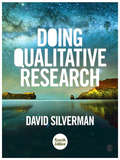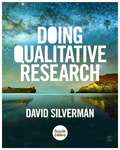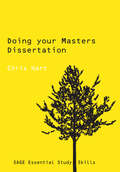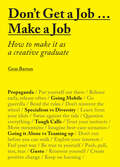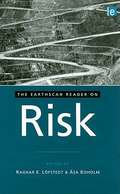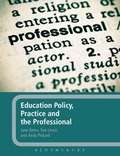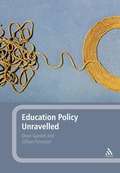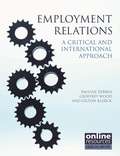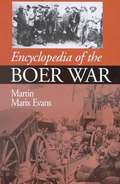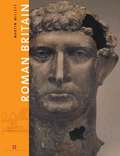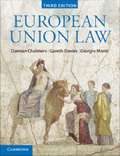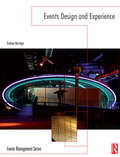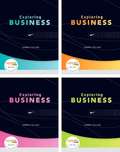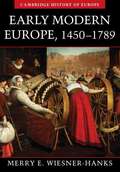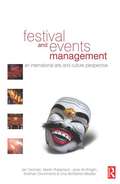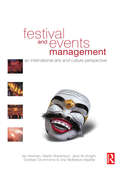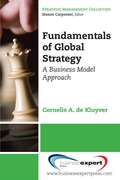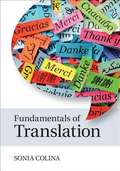- Table View
- List View
Doing Qualitative Research: A Practical Handbook (4th edition)
by Professor David SilvermanIn the fourth edition of his best-selling textbook, David Silverman provides a step-by-step guide to planning and conducting qualitative research. Using real examples from real postgraduate students, the book makes it easy to link theory to methods and shows how to move from understanding the principles of qualitative research to doing it yourself. The new edition has been fully updated and now includes: - a brand new chapter on formulating a research question appropriate for qualitative research - an expanded discussion of the role of theory in research - extended discussion of case study research and the number of cases needed for effective qualitative research - further coverage of focus groups and analysing internet data - new student examples from around the world - a new section on the common pitfalls encountered in qualitative research - an expanded companion website with more student examples and videos. Filled with exercises to test your understanding and develop your skills, as well as David's own tips for research success based on years of experience, this book is essential reading for anyone doing qualitative research. Available with Perusall--an eBook that makes it easier to prepare for class Perusall is an award-winning eBook platform featuring social annotation tools that allow students and instructors to collaboratively mark up and discuss their SAGE textbook. Backed by research and supported by technological innovations developed at Harvard University, this process of learning through collaborative annotation keeps your students engaged and makes teaching easier and more effective. Learn more.
Doing Qualitative Research: A Practical Handbook (4th ediction) (PDF)
by Professor David SilvermanIn the fourth edition of his best-selling textbook, David Silverman provides a step-by-step guide to planning and conducting qualitative research. Using real examples from real postgraduate students, the book makes it easy to link theory to methods and shows how to move from understanding the principles of qualitative research to doing it yourself. The new edition has been fully updated and now includes: - a brand new chapter on formulating a research question appropriate for qualitative research - an expanded discussion of the role of theory in research - extended discussion of case study research and the number of cases needed for effective qualitative research - further coverage of focus groups and analysing internet data - new student examples from around the world - a new section on the common pitfalls encountered in qualitative research - an expanded companion website with more student examples and videos. Filled with exercises to test your understanding and develop your skills, as well as David's own tips for research success based on years of experience, this book is essential reading for anyone doing qualitative research. Available with Perusall--an eBook that makes it easier to prepare for class Perusall is an award-winning eBook platform featuring social annotation tools that allow students and instructors to collaboratively mark up and discuss their SAGE textbook. Backed by research and supported by technological innovations developed at Harvard University, this process of learning through collaborative annotation keeps your students engaged and makes teaching easier and more effective. Learn more.
Doing Your Masters Dissertation (1st edition)
by Dr Christopher HartDoing Your Masters Dissertation is a practical and comprehensive guide to researching, preparing and writing a dissertation at Masters level. It adopts a well-structured and logical approach, and takes the student through all the stages necessary to complete their research and write a successful dissertation. Key features of the book include: Step-by-step coverage - sections on choosing a topic, research design, methodology and presenting data and writing up An up-to-date list of key reference materials, both printed and electronic Advice on ethical guidelines Information on assessment criteria Student-focused throughout with a broad range of worked examples and guidelines for further reading. Written in an engaging and accessible manner, this textbook is an essential resource for postgraduate students across the social sciences required to complete a Masters dissertation. SAGE Study Skills are essential study guides for students of all levels. From how to write great essays and succeeding at university, to writing your undergraduate dissertation and doing postgraduate research, SAGE Study Skills help you get the best from your time at university. Visit the SAGE Study Skills website for tips, quizzes and videos on study success!
Doing Your Masters Dissertation (1st edition) (PDF)
by Dr Christopher HartDoing Your Masters Dissertation is a practical and comprehensive guide to researching, preparing and writing a dissertation at Masters level. It adopts a well-structured and logical approach, and takes the student through all the stages necessary to complete their research and write a successful dissertation. Key features of the book include: Step-by-step coverage - sections on choosing a topic, research design, methodology and presenting data and writing up An up-to-date list of key reference materials, both printed and electronic Advice on ethical guidelines Information on assessment criteria Student-focused throughout with a broad range of worked examples and guidelines for further reading. Written in an engaging and accessible manner, this textbook is an essential resource for postgraduate students across the social sciences required to complete a Masters dissertation. SAGE Study Skills are essential study guides for students of all levels. From how to write great essays and succeeding at university, to writing your undergraduate dissertation and doing postgraduate research, SAGE Study Skills help you get the best from your time at university. Visit the SAGE Study Skills website for tips, quizzes and videos on study success!
Don't Get a Job...Make a Job: How to make it as a creative graduate
by Gem BartonToo often a design or architecture degree is seen as a means to an end (a job in an established practice). But imagine for one moment that there are no employers, no firms to send your CV to, no interviews to be had – what would you do? How would you forge your own path after graduation?The current economic climate has seen many graduates chasing a finite number of positions. The most ingenious and driven designers have found weird and wonderful ways of making opportunities for themselves, often by applying their skills across the creative disciplines of art, design, architecture and interiors. Knowing what you want from your design career and being able to adapt your strategy to suit is basic and vital – just like in the wild, designers need to evolve.The book celebrates the various strategies that students and graduates are taking to gain exposure, while also including interviews and inspirational advice from those who are now enjoying success as a result of their creative approach to employment.
The Dyslexia Handbook: Procedures Concerning Dyslexia and Related Disorders
by Texas Education AgencyThe Texas Education Agency (TEA) handbook contains the SBOE-approved procedures concerning dyslexia and related disorders. It provides guidelines for school districts to follow as they identify and provide services for students with dyslexia. Additionally, the handbook provides school districts and parents/guardians with information regarding the state's dyslexia statutes and their relation to these federal laws.
Earthscan Reader Series: The Earthscan Reader on Risk (PDF)
by Ragnar LofstedtThis new anthology is a comprehensive introduction to the field of risk theory. The introduction provides the ideal starting point for students and professionals new to risk studies and offers a concise refresher for researchers and practitioners. Coverage includes the origins of the 'concept of risk' and its often misunderstood cousin 'uncertainty,' before moving on to address risk perception, risk communication, the idea of trust and post trust as well as risk in policy and regulation with a close look at the Precautionary Principle. Following the introduction, the volume includes a selection of the most significant and influential works on risk in their entirety. These selections, organized thematically to cover the breadth and depth of the field, provide greater detail and elaborate on the key themes and major developments in risk studies. Together they comprise the essential literature necessary for a full understanding of risk theory and practice on any issue and in any context.
Economics: Theory Through Applications
by Russell Cooper A. Andrew JohnThis textbook, Economics: Theory Through Applications, centers around student needs and expectations through two premises: ... Students are motivated to study economics if they see that it relates to their own lives. ... Students learn best from an inductive approach, in which they are first confronted with a problem, and then led through the process of solving that problem. Many books claim to present economics in a way that is digestible for students; Russell and Andrew have truly created one from scratch. This textbook will assist you in increasing students' economic literacy both by developing their aptitude for economic thinking and by presenting key insights about economics that every educated individual should know.
Education Policy, Practice and the Professional (PDF)
by Sue Lewis Andy Pickard Jane BatesThis introductory textbook explores education policy, looking at where we came from, where we are, and where we are going. The book includes commentaries, case studies and other forms of contributions from lecturers of education studies at different institutions through the British Education Studies Association. Alternate ISBN 9781441115201
Education Policy Unravelled (PDF)
by Gillian Forrester Dean GarrattEducation Policy Unravelled examines that nature of contemporary education policy, its purposes and political formation. It charts the continuity of policy development along neo-liberal lines, moving from New Labour to the emerging position of the Coalition government. Alternative ISBNs 9781441166180 9781474270052 9781474270069
Employment Relations: A Critical and International Approach
by Pauline Dibben Gilton Klerck Geoffrey WoodThis text takes an integrated international approach and perspective and is designed to map on to the revised CIPD module. It takes a critical approach for those wanting to engage in critical debates, combined with an academic approach, drawing on the latest research.
Encyclopedia of the Boer War: 1899-1902 (PDF)
by Martin Marix EvansThis volume covers all aspects of the Boer War including its origins, military strategy and tactics, the main battles and sieges, the principal political and military figures, weaponry, and subjects such as the role of the railways, the treatment of the wounded, and the use of concentration camps.;The encyclopedia shows how the camps intended to house refugees became infamous concentration camps, how the peace negotiated between the Boers and the British established the conditions under which apartheid was able to flourish and how the war marked an important stage in the evolution of warfare and is often regarded as the first modern war.;A number of original documents are reprinted in this book, including the main body of the report on concentration camps and extracts from the minutes of the peace negotiations.;Entries include: Afrikaner uprisings, Battle of Elandslaagte, Battle of Elands River Post, Battle of Spioenkop, Bloemfontein, Chief Commandant Christaan Rudolf De Wet, Colonel J.Y.F. Blake, Commandant-general Louis Botha, concentration camps, General Sir Redvers Buller, The Jameson Raid, Lieutenant H.H.R. Breaker Morant, Major Frederick Russell Burnham, maps, Maxim-Vickers machine gun, Siege of Ladysmith, Siege of Mafeking, and Winston Churchill. Alternate ISBN 9781576073995
English Heritage: Roman Britain (Revised edition)
by Martin MillettAfter the invasion in AD 43 by the Emperor Claudius, the Romans occupied Britain for four centuries - but what exactly did this 'occupation' mean to the island's inhabitants? In this classic work - widely recommended on reading lists everywhere - eminent archaeologist Martin Millett examines the latest archaeological and historical sources to help us to understand the cultural, social and economic effects of 400 years of Roman rule. Using over 100 photographs, plans and drawings, many never published together before, Professor Millet breaks away from the traditional historical narrative to explore the central themes of life in Roman Britain.
English Heritage: Roman Britain (Revised edition) (PDF)
by Martin MillettAfter the invasion in AD 43 by the Emperor Claudius, the Romans occupied Britain for four centuries - but what exactly did this 'occupation' mean to the island's inhabitants? In this classic work - widely recommended on reading lists everywhere - eminent archaeologist Martin Millett examines the latest archaeological and historical sources to help us to understand the cultural, social and economic effects of 400 years of Roman rule. Using over 100 photographs, plans and drawings, many never published together before, Professor Millet breaks away from the traditional historical narrative to explore the central themes of life in Roman Britain.
European Union Law (3rd edition) (PDF)
by Giorgio Monti Damian Chalmers Gareth DaviesUpdated to reflect the new post-crisis Europe, this market-leading textbook presents the current state of EU institutional law, the internal market and competition law. Retaining the authority, accessibility and critical analysis of previous editions, the new edition will continue to be the preferred choice of European law teachers and students. As the preferred choice of both teachers and students, this textbook offers an unrivalled combination of expertise, accessibility and comprehensive coverage. The new edition reflects the way the economic crisis has impacted the shape and nature of European Union law. Materials from case law, legislation and academic literature are integrated throughout to expose the student to the broadest range of views. Additional online material on the application of EU law in non member states and on rulings on the Fiscal Compact ensures the material is completely current. The new edition includes a timeline which charts the evolution of the EU project. Written in a way which encourages sophisticated analysis, the book ensures the student's full engagement with sometimes complex material. More importantly, it offers the clarity which is essential to understanding. A required text for all interested in European Union law.
Events Design and Experience (1st Edition) (PDF)
by Graham BerridgeFor the first time Events Design and Experience draws together the relationship between event design and the experience of consumers and participants. It explores and analyses the event experience of the individual and how this can be controlled' by design.By drawing upon ongoing research conducted over several years into the experiences of groups and individuals who attend events this text will ask questions such as: What was the rationale behind a particular event being designed in a certain way? What was the actual experience of consumers? How was the event materially delivered and did the experience created provide a satisfactory outcome? How can experiences be understood (via semiotics) especially the physical elements of an event?Structured in four sections, Events Design and Experience discusses:* What are events? An overall view of the industry, its definitions and market demand. It also covers an analysis of previous literature, and draws upon real life events such as Wembley plc, Leapfrog Corporate events and the British Cycling federation* What is an event experience? An explanation of the nature and stages of experience, and the emergence of the experience industry itself. Cases such as the Proms, London Fashion week ands the Nike Fun run are used to illustrate.* Designing Experiences. Considers how design itself can impact upon the experience, in some cases fundamentally changing the nature of experience. It asks the question of how experiences are designed and what do they signify to the customer once complete.* Analysing Event Experiences. Considers how experiences can be analysed and evaluated looking at the artificiality of the event and how this reflects in the experience of consumers. Also includes a review of the psychological processes of perception and interpretation and how meaning and experience can be analysed, and how we may begin to unravel the meanings attributed to certain events. With international case studies throughout, Events Design and Experience has a coherent user-friendly structure including chapter summaries, review exercises and topics for discussion to consolidate understanding.
Exploring Business
by Karen CollinsCollins is the only Introduction to Business book to teach students the topics of business through an in-depth study of a single company--Nike. How do you show your students the relationships between what they are learning in the classroom and what happens in the real business world? What happens when your students don't see the connections between the theory they are learning in the classroom and what is happening in the real business world?
Facts 1010 Study Guide: Early Modern Europe, 1450-1789 (1st edition) (PDF)
by Merry E. Wiesner-HanksCovering European history from the invention of the printing press to the French Revolution, this accessible and engaging textbook offers an innovative account of people's lives, from a variety of backgrounds, in the early modern period and within the global context of European developments. Six central topics - individuals in society, politics and power, cultural and intellectual life, religion, economics and technology - are explored in two chronological sections, 1450-1600 and 1600-1789. The text takes in Europe in its entirety, eastward to the Ottoman Empire, northward to Sweden, and southward to Portugal, includes European colonies overseas, and integrates religious, ethnic, gender, class, and regional differences. Students are encouraged to think about continuities as well as changes across this formative period and throughout the text, maps, illustrations, timelines, and textboxes of original sources and featured topics illuminate the narrative.
Festival and Events Management: An International Arts and Culture Perspective (PDF)
by Ian YeomanFestival and Events Management: an international perspective is a unique text looking at the central role of events management in the cultural, tourism and arts industries. With international contributions from industry and academia, the text looks at the following: Events cultural environments, Managing the arts leisure experience, Marketing, policies and strategies of art and leisure management. Chapters include exercises, and additional teaching materials and solutions to questions are provided as part of an accompanying online resource.
Festival and Events Management: An International Arts and Culture Perspective (1st Edition) (PDF)
by Ian YeomanFestival and Events Management: an international perspective is a unique text looking at the central role of events management in the cultural, tourism and arts industries. With international contributions from industry and academia, the text looks at the following: * Events amp; cultural environments * Managing the arts amp; leisure experience * Marketing, policies and strategies of art and leisure management Chapters include exercises, and additional teaching materials and solutions to questions are provided as part of an accompanying online resource.
Festival and Events Management (1st Edition): An International Arts And Culture Perspective
by Ian YeomanFestival and Events Management: an international perspective is a unique text looking at the central role of events management in the cultural, tourism and arts industries. With international contributions from industry and academia, the text looks at the following: * Events amp; cultural environments * Managing the arts amp; leisure experience * Marketing, policies and strategies of art and leisure management Chapters include exercises, and additional teaching materials and solutions to questions are provided as part of an accompanying online resource.
Fundamentals of Global Strategy
by Cornelis A. de KluyverThis book looks at the opportunities and risks associated with staking out a global competitive presence and introduces the fundamentals of global strategic thinking. We define crafting a global strategy in terms of change: how a company should change and adapt its core (domestic) business model to achieve a competitive advantage as it expands globally. The conceptual framework behind this definition has three fundamental building blocks: a company's core business model, the various strategic decisions a company needs to make as it globalizes its operations, and a range of globalization strategies for creating a global competitive advantage. A business model is defined in terms of four principal components: (a) market participation--who its customers are, how it reaches them and relates to them; (b) the value proposition--what a company offers its customers; (c) the supply chain infrastructure--with what resources, activities and partners it creates its offerings; and finally, (d) its management model--how it organizes and coordinates its operations. Globalization requires a company to make strategic decisions about each component of the business model. Market participation decisions include choosing which specific markets or segments to serve, domestically or abroad; what methods of distribution to use to reach target customers; and how to promote and advertise the value proposition. Globalization decisions about the value proposition touch the full range of tangible and intangible benefits a company provides to its customers (stakeholders). Decisions about a company's value chain infrastructure deal with such questions as, What key internal resources and capabilities has the company created to support the chosen value proposition and target markets? What partner network has it assembled to support the business model? How are these activities organized into an overall, coherent value creation and delivery model? Finally, strategic decisions about the global management dimension are concerned with a company's choices about a suitable global organizational structure and decision-making process. We use Pankaj Ghemawat's well-known "AAA Triangle" framework to define three generic approaches to global value creation. Adaptation strategies seek to increase revenues and market share by tailoring one or more components of a company's business model to suit local requirements or preferences. Aggregation strategies focus on achieving economies of scale or scope by creating regional or global efficiencies; they typically involve standardizing a significant portion of the value proposition and grouping together development and production processes. Arbitrage is about exploiting economic or other differences between national or regional markets, usually by locating separate parts of the supply chain in different places.
Fundamentals of Translation (PDF)
by Sonia ColinaThis textbook provides a non-technical introduction to the basic concepts of translation theory and practice, with numerous activities, exercises and examples from a wide variety of languages. Suitable for non-specialists as well as language industry professionals, this textbook is ideal for readers seeking a wide and practical understanding of translation. Clear and concise, this textbook provides a non-technical introduction to the basic and central concepts of translation theory and practice, including translation briefs, parallel texts and textual functions, cohesion and coherence, and old and new information. Colina focuses on the key concepts that beginning students of translation, practising translators, language students and language professionals need to understand. Numerous exercises (discussion, group and individual) at the end of each chapter and 'Practice' activities throughout each chapter allow students to self-assess their practical understanding of chapter topics. In addition, examples, figures and text extracts from a wide variety of world languages contextualise chapter material and produce a lively and accessible narrative. Suitable for non-specialists with no prior experience of translation, it will also be of interest to practising translators, language students and language industry professionals who wish to gain a wider and up-to-date understanding of translation.
General Chemistry
by Bruce Averill Patricia EldredgeThe overall goal of the authors with General Chemistry: Principles, Patterns, and Applications was to produce a text that introduces the students to the relevance and excitement of chemistry. Although much of first-year chemistry is taught as a service course, Bruce and Patricia feel there is no reason that the intrinsic excitement and potential of chemistry cannot be the focal point of the text and the course. So, they emphasize the positive aspects of chemistry and its relationship to students' lives, which requires bringing in applications early and often. In addition, the authors feel that many first year chemistry students have an enthusiasm for biologically and medically relevant topics, so they use an integrated approach in their text that includes explicit discussions of biological and environmental applications of chemistry. Topics relevant to materials science are also introduced to meet the more specific needs of engineering students.
Geopolitics: An Introductory Reader
by Jason Dittmer Joanne SharpIt has been increasingly impossible to think about our changing world without coming across the term 'geopolitics'. In the wake of the invasion and occupation of Iraq by the United States, United Kingdom, and others, geopolitics has been offered as an explanation for the occupation's failure to reinvent the Iraqi state and as a blueprint for future action. But what is 'geopolitics'? Drawing both on academic and political material, this book introduces readers to the concept of geopolitics, from the first usage of the term to its more recent reconceptualisations. The concept of geopolitics is introduced through four thematic sections - Imperial Geopolitics, Cold War Geopolitics, Geopolitics after the Cold War and Reconceptualising Geopolitics. Each section includes key writings from a range of diverse and leading authors such as Said, Agnew, Dalby, O Tuathail, Gregory, Barnett and Kaplan, and is accompanied by a critical introduction by the editors to guide the reader through the material. This Reader establishes the foundations of geopolitics while also introducing readers to the continuing significance of the concept in the 21st century. This Reader provides an essential resource that exposes students to original writing. The Editors provide a pathway through the material with Section Introductions to assist the readers understanding of the context of the material and impacts of the writings. The readings included draw from a range of authors, writing from a range of locations. The Reader concludes with the latest changes in geopolitical thought, incorporating feminist and other perspectives. Alternate ISBNs 9780415666626 9780415666633
